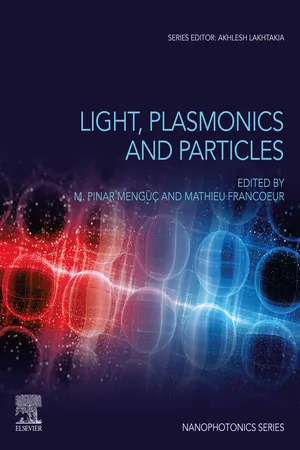
- 616 pages
- English
- ePUB (mobile friendly)
- Only available on web
Light, Plasmonics and Particles
About This Book
Light, Plasmonics and Particles focuses on the fundamental science and engineering applications of light scattering by particles, aerosols and hydrosols, and of localized plasmonics. The book is intended to be a self-contained and coherent resource volume for graduate students and professionals in the disciplines of materials science, engineering and related disciplines of physics and chemistry. In addition to chapters related to fundamental concepts, it includes detailed discussion of different numerical models, experimental systems and applications.
In order to develop new devices, processes and applications, we need to advance our understanding of light-matter interactions. For this purpose, we need to have a firm grasp of electromagnetic wave phenomena, and absorption and scattering of waves by different size and shape geometrical objects. In addition, understanding of tunneling of waves based on electron and lattice vibrations and coupling with the thermal fluctuations to enhance near-field energy transfer mechanisms are required for the development of future energy harvesting devices and sensors.
- Reviews the fundamental science, available computational tools, experimental systems, and a wide range of applications of plasmonics
- Connects the cross-cutting science of the physics of electromagnetic light scattering by particles, plasmonics and phononic interactions at the electronic, molecular and lattice levels of materials
- Reviews applications of light-matter interactions of particles, aerosols, hydrosols and localized plasmonics
Frequently asked questions
Information
Table of contents
- Cover image
- Title page
- Table of Contents
- Copyright
- Dedication
- Contributors
- Preface
- Chapter 1: Overview of light, plasmonics, and particles
- Chapter 2: Maxwell's equations for single-scattering particles
- Chapter 3: Fluctuational electrodynamics and thermal emission
- Chapter 4: The Lorenz-Mie theory
- Chapter 5: Optical force categorizations in the generalized Lorenz-Mie theory
- Chapter 6: T-matrix method for particles of arbitrary shape and composition
- Chapter 7: Applications of Maxwell's equations to light scattering by dielectric particles
- Chapter 8: Scattering by compact particles using surface integral equations
- Chapter 9: Discrete dipole approximation
- Chapter 10: Discrete dipole approximation with surface interaction
- Chapter 11: The thermal discrete dipole approximation and the discrete system Green's function methods for computational near-field radiative heat transfer
- Chapter 12: Rational design and optical tuning of plasmonic nanoparticles
- Chapter 13: Particle characterization with laboratory nephelometers
- Chapter 14: Imaging aerosol particles with digital in-line holography
- Chapter 15: Polarimetric remote sensing of cometary particles
- Chapter 16: Optical properties of nonspherical, light-absorbing particles: Black carbon and mineral dust aerosols
- Chapter 17: Carbonaceous particles in flames and fires
- Chapter 18: Radiative cooling paints
- Chapter 19: Plasmonic nanofluids for solar thermal applications
- Chapter 20: Near-field energy harvesting
- Chapter 21: Nanoantennas
- Chapter 22: Near-field radiative transfer for biologically inspired structures
- Chapter 23: Biosensing based on plasmonic devices
- Chapter 24: Plasmon and phonon polaritons in planar van der Waals heterostructures
- Chapter 25: Spectrally selective filters and their applications
- Chapter 26: Concluding remarks and future directions
- Glossary of symbols
- Index